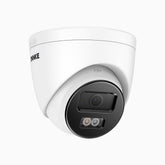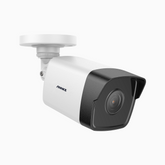Bullet-Dome All-in-One vs Bullet-PTZ Linkage Systems: From Structure and Principles to Real-World Applications
As the video surveillance industry continues to evolve, users’ demands for “seeing clearly, covering broadly, reacting rapidly” are higher than ever. Traditional single-camera monitoring solutions—while useful for basic recording—are increasingly insufficient to meet the needs of wide-area coverage, smart alarms and proactive tracking.

To overcome these limitations, the industry is shifting toward multi-camera collaboration and intelligent linkage. Two prominent system typologies have emerged: the bullet-dome all-in-one camera and the bullet-PTZ linkage system. Although they share conceptual similarities, their structural implementations, functional logics and application targets differ significantly.
In this article, we provide a comprehensive analysis of these two system types—covering their structure and principles, distinguishing features, application value—and offer guidance on how to choose between them. We will also reference two real ANNKE product examples: the ANNKE WCD600 (as an all-in-one solution) and the ANNKE NCT425 (as a linkage system example).
1. Evolution from Single-Camera to Collaborative Smart Surveillance
Historically, security systems relied on single cameras operating in isolation. When an event occurred, operators needed to manually switch views or control PTZ cameras, leading to delays and potential blind spots.
With advances in AI, networking and analytics, we are now entering an era of intelligent collaborative surveillance. Front-end cameras not only detect but also trigger and coordinate with other devices or the recording platform, enabling automatic detection, intelligent response and cross-device coordination.
In this context:
- The bullet-dome all-in-one camera focuses on single-device dual-view monitoring.
- The bullet-PTZ linkage system emphasizes multi-device coordination and active tracking.
2. Core Concepts: Bullet Camera, Dome/PTZ Camera and Linkage Mechanism
2.1 Bullet Camera (Fixed / Wide-View Camera)
A bullet camera typically uses a fixed lens and field of view, offering stable video capture and cost-efficient coverage. Nowadays, many bullet cameras include AI analytics—such as human/vehicle detection or intrusion alerts—and act as the “detector” in the system, identifying anomalies in the monitored scene.
2.2 Dome / PTZ Camera
Dome (or speed dome) cameras often support horizontal pan, vertical tilt and optical zoom (PTZ), enabling them to track moving targets, zoom in on details and cover wide areas from a single installation point. They serve as the “tracker” in a coordinated system.
It is important to note—when assessing combined systems—that some “dome” modules may not actually support full PTZ functionality. In certain integrated devices, the “dome part” is simply a fixed-focus lens providing a secondary view rather than full pan/tilt/zoom control. Thus, one must distinguish between a fixed-focus dome unit and a true PTZ dome unit.
2.3 Linkage (Coordination)
Linkage refers to the mechanism by which one camera or system detects an event and then automatically triggers another camera or system component to perform a specific action—such as re-orientation, zooming, recording tagging or alarm activation. This is the foundation of “active” surveillance vs traditional passive capture.
3. Bullet-Dome All-in-One Cameras: Integrated Dual-View Solutions
The bullet-dome all-in-one camera integrates both a fixed bullet lens for wide-view coverage and a dome/ball-type lens for narrower view or detail monitoring, all within a single housing.
3.1 Structure & Implementation
These devices typically include:
- A fixed bullet lens for monitoring the overall scene;
- A dome/ball lens module for focusing or zooming into key areas;
- Embedded algorithm or logic to coordinate the two lenses.
The result: a single device capable of capturing both a broad overview and a targeted view.
3.2 Two Design Variants
| Variant | Dome Module Function | Features |
| Smart PTZ All-in-One | Full pan/tilt and optical zoom | Enables automatic tracking, suitable for mid- to high-end applications |
| Fixed-Focus Dual Lens | Secondary lens has fixed angle and focus | Lower cost, provides “overview + detail” but no dynamic tracking |
For example, ANNKE’s WCD600 is a dual-lens system capturing two directions simultaneously; though its design is more oriented to dual-view than full PTZ linkage.
3.3 Advantages & Limitations
Advantages:
- Integration simplifies installation and cabling;
- Synchronized output of overview + detail;
- Efficient for single-point deployment.
Limitations:
- Coverage is limited to the installed point of view;
- The fixed-focus variant cannot actively track moving targets;
- Less flexibility for large-scale, multi-point surveillance.
Thus, bullet-dome all-in-one cameras shine in single-location, moderate coverage scenarios such as retail storefronts, building entrances or interior corridors.
4. Bullet-PTZ Linkage Systems: Coordinated Multi-Device Smart Tracking
In contrast, a bullet-PTZ linkage system comprises multiple independent cameras—a set of fixed bullet cameras and a PTZ dome camera—networked together to perform coordinated detection and tracking.
4.1 Operational Workflow
- Fixed bullet cameras monitor the environment for events (motion, human detection, boundary crossing).
- On detection, the bullet camera sends a trigger or event signal to the PTZ dome.
- The PTZ camera receives the signal, rotates/tilts and zooms to the target area, initiating tracking.
- The system records relevant video, triggers alert or records event metadata, forming a full “detect → track → record” chain.
4.2 Technical Strengths
- Clear functional division: bullet camera detects; PTZ camera tracks;
- Event-driven automation: tracking occurs without manual intervention;
- Multi-camera collaboration: one PTZ may link with multiple bullet cameras, enabling wide-area monitoring;
- Flexible deployment and expansion: cameras may be placed across different zones yet coordinated as one system.
ANNKE’s NCT425 is an example of a dual-lens PTZ camera with integrated capabilities, suitable for such linkage systems.
4.3 Typical Application Scenarios
- Industrial perimeter & factory sites: fixed cameras detect perimeter intrusion; PTZ camera tracks the intruder;
- Residential complexes & parking facilities: entry-point bullet cameras detect vehicles or individuals; PTZ camera zooms in to capture license plates or suspicious movement;
- City surveillance & transport hubs: broad area monitoring combined with targeted tracking of moving objects across camera points.
Bullet-PTZ linkage systems excel in settings needing large-area active surveillance, high event responsiveness and multi-point coordination.
5. Comparison & Selection Guidance
| Dimension | Bullet-Dome All-in-One | Bullet-PTZ Linkage System |
| System Architecture | Single device with integrated lenses | Collaborative multi-device configuration |
| Dome Module Capability | May be PTZ or fixed-focus | Typically full PTZ unit |
| Installation Flexibility | Simplified, fixed location | Distributed deployment, covers multiple zones |
| Coverage & Tracking | Limited to one installation point | Large-area, multi-point tracking possible |
| Intelligence Level | Dependent on internal design | Built for event-triggered, automated response |
| Cost & Scalability | Lower cost per point, less scalable | Higher system complexity, greater scalability |
Selection Recommendations:
- Choose bullet-dome all-in-one if your requirement is single-location monitoring with both overview and detail views, and where installation simplicity is key.
- Choose bullet-PTZ linkage if you require active tracking, wide-area coordination and rapid event response across multiple points or zones.
6. ANNKE’s Technical Capabilities & Ecosystem
ANNKE brings a robust technical foundation to both system types:
- Advanced AI analytics: human/vehicle detection, intrusion recognition, license plate capture and alert triggering;
- Seamless device linkage: synchronized control between bullet and PTZ cameras via ANNKE NVRs or VMS platforms;
- Precision PTZ control: enabling fast, stable transitions during event-initiated tracking;
- Unified multi-view display: support for simultaneous overview and detail view, facilitating faster situational awareness.
Together, these capabilities enable ANNKE solutions to deliver holistic event detection and tracking workflows across diverse deployments.
7. Conclusion: Collaboration is the Future of Smart Surveillance
The development of bullet-dome all-in-one cameras and bullet-PTZ linkage systems marks a significant shift in video surveillance—from passive single-camera capture toward collaborative, intelligent, event-driven systems.
- All-in-one solutions prioritize integration and ease of deployment.
- Linkage systems emphasize coordination and intelligent responsiveness.
As AI, networked device protocols and PTZ technology continue to mature, smart collaborative surveillance will become an essential part of modern security infrastructure. ANNKE remains committed to advancing these innovations—helping users around the world move from passive monitoring to proactive protection.
















Leave a comment
Please note, comments need to be approved before they are published.